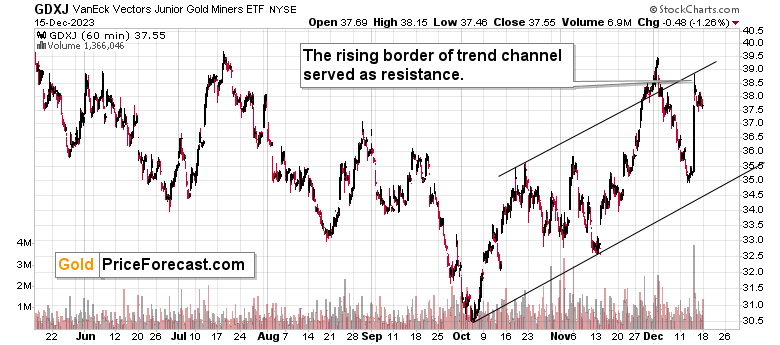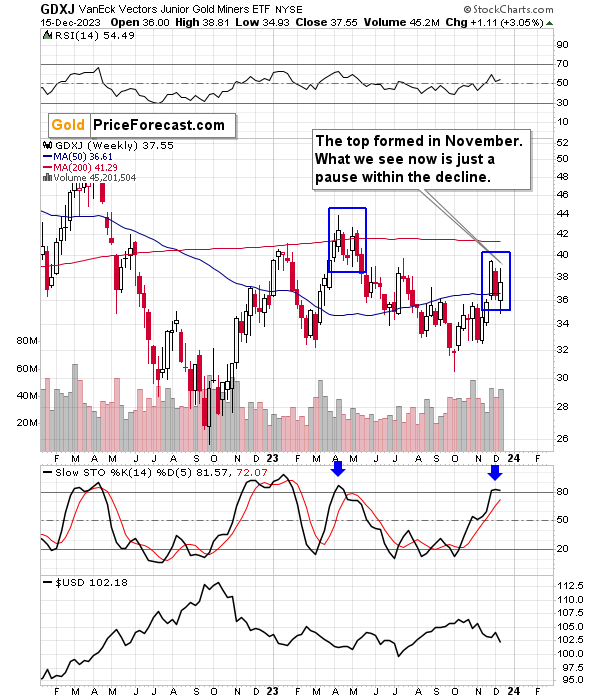Did you notice what happened in gold, miners, and stocks at the end of Friday’s session? It was small and huge at the same time.
Small because the size of the price moves that we saw in the final hour of trading was nothing to write home about per se. Huge because the shape of the most recent price moves has meaningful implications.
Before we move to the chart featuring GLD, GDXJ, and SPY, let’s take a moment to consider the importance of looking at the markets from various perspectives.
Have you heard that the market is nasty? I haven’t but saying that wouldn’t be far from the truth. You see, the market has this special power of discovering your weaknesses and then using them against you.
You’re impatient? And you buy options that are about to bring you huge gains if the market moves right away in your preferred way? Here’s a prolonged consolidation that will make your options expire worthless… and then you’ll get the move that you were waiting for.
You’re too bold? And you’re entering huge positions because you’re surely (!) be correct about the market moves? Here’s a more-or-less random counter-trend move that makes you panic and get out of the position right before it returns to its trend and makes you a lot of money. Why would you panic? Because, due to the oversized position, your paper losses (you didn’t really incur them, but as you were monitoring the value of your portfolio it felt (!) like you did) were too painful for you to wait out the correction.
Those examples are relatively simple, but there are more sophisticated things that the market can use against you. In reality, working on oneself and on one’s own character has a tremendous rate of return, not only because it “not only” makes one happier and more fulfilled, but because it also enables one to better handle whatever the market throws at them.
Now, what can we do with this “nastiness” of markets in addition to the above? We can mitigate the emotional effect that the market has on us by applying more than one technique, more than one perspective, looking at more than one market, and so on. It’s easy for the market to get a hold of one’s emotions if one only looks at it from one perspective.
From that point of view, it’s easy to panic when we see some kind of sudden price move. Because this sudden price moves changes everything… Everything that we’re looking at that is. It might not change 99% of things, but if it’s just the 1% that we’re paying attention to, then this 1% is “our everything”, even though the reality is completely different.
You probably heard about missing the forest while being too focused on the trees. That’s one of the ways to describe the above. It’s a nice approximation, but it might be a bit misleading because it emphasizes only the broader context, while in reality sometimes the extra context comes from zooming in, not out.
To be completely clear, the more angles one uses to look at a given situation, the greater the chance of making the right decision and the lower the chance of getting tricked by the market’s “nastiness”.
That’s why, in my analyses, I focus on so many markets and so many perspectives (and I monitor many more charts, tools, techniques, and perspectives than I’m describing). In today’s analysis, I’m going to introduce you to a very short-term view of the markets, and I’ll then zoom out twice.
The chart below is based on hourly price changes – each candlestick represents one hour of trading.
Let’s start with the middle part of the chart – it features the SPY ETF, a popular proxy for the broad market this ETF is based on the S&P 500 Index.
In the case of the SPY, we clearly see that it tried to rally at the end of Friday’s session, but it failed, and it closed the day and week relatively close to its intraday lows. In other words, it formed an intraday reversal in terms of hourly candlesticks.
The same happened in the case of junior mining stocks (GDXJ) and (to a smaller extent, but still) in GLD.
The implications of reversals are bearish, but since we saw them in all three: gold, stocks, and junior miners, they confirm each other, and the odds of seeing a decline early this week increase.
Let’s focus on the GDXJ and its hourly price moves.

In Friday’s regular Gold Trading Alert, I wrote the following:
The upper border of the trend channel was reached and the GDXJ reversed from there.
Based on the above chart alone, we’re likely to see a move lower, quite likely to $35 or so. However, based on many other charts, it’s likely that the move to $35 will be just the first step in a way to much lower levels.
After all, the indications from short-term charts are less important than ones from medium-term charts, which in turn are less important than ones from long-term charts.
Indeed, we saw a move lower during Friday’s session. However, since the GDXJ didn’t move to at least $35, the bearish implications of the above chart (and GDXJ’s move to the upper border of the trade channel), remain up-to-date.

Zooming out provides us with a picture that continues to point to lower GDXJ prices, i.a. due to the recent sharp increase in volume levels.
In case of this ETF, the link between big-volume rallies and local tops is not as clear as it is in case of silver, but it’s still present. I marked the similar cases with arrows and in 6 out of 9 such cases, big-volume rallies marked local tops, or those tops followed very soon. Only in 3 out of 9 cases, big rallies followed.
Interestingly, all those three bullish cases were preceded by declines that were much bigger than what we saw recently. This suggests that the bullish analogies are not the correct ones. The bearish ones are.
Zooming out helps to put things into perspective.

Looking at the above chart, two things stand out:
- The final top for the recent upswing most likely formed in November, and what we see now is just a pause in the post-top decline. Right after the top, GDXJ declined, and this week it corrected. It’s normal for the markets not to move up or down in a straight line, so this kind of performance is normal.
- The recent top, the subsequent decline, and then another move higher that ends with a specific candlestick (white one, with distinct knots on both ends) is just like what we saw at the 2023 top.
The implications of both points are bearish.
Now, let’s consider the situation in the USD Index. I commented on it in the final, intraday Alert of the previous week. I wrote the following:
The USD Index is moving higher today, and while it didn’t move back above its 61.8% Fibonacci retracement just yet, it’s definitely moving north, and such an invalidation could take place any hour now.
The move below the early-August lows was already invalidated, but a move back above the 61.8% retracement will be the thing that confirms that the bottom is most likely in.
Generally, it takes three consecutive closes below a certain level to confirm a breakdown. So far we saw just one, and in today’s session, the USDX moved higher. Invalidation later today or on Monday seems very much doable, and given how oversold the USD Index is, it’s likely to happen.
The situation in the EUR/USD also provides the context, and it makes the above-mentioned invalidation even more likely.
After I wrote the above, the USD Index moved even higher, and it closed the week only slightly below the 61.8% Fibonacci retracement level. This means that the USD Index is ripe for the invalidation of the move below the 61.8% retracement.
